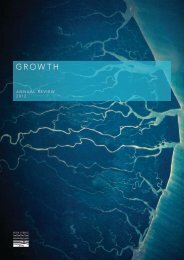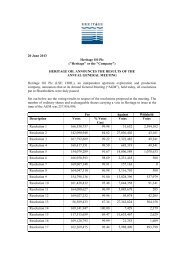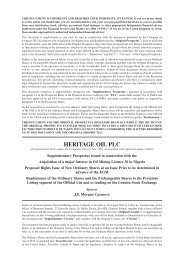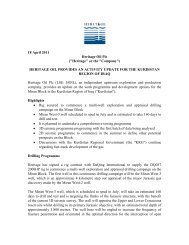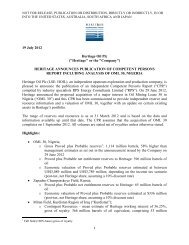Prospectus re Admission to the Official List - Heritage Oil
Prospectus re Admission to the Official List - Heritage Oil
Prospectus re Admission to the Official List - Heritage Oil
Create successful ePaper yourself
Turn your PDF publications into a flip-book with our unique Google optimized e-Paper software.
RPS Energy<strong>Heritage</strong> <strong>Oil</strong> – Competent Persons ReportIn p<strong>re</strong>vious <strong>re</strong>serves <strong>re</strong>ports for <strong>Heritage</strong>, RPS has <strong>re</strong>viewed <strong>the</strong> geology of <strong>the</strong> field. As no new geologicalor geophysical data have been made available, <strong>the</strong> p<strong>re</strong>vious information was used as a basis for this <strong>re</strong>port,updated with <strong>the</strong> 2006/07 production data.The time <strong>to</strong> depth conversion of <strong>the</strong> seismic interp<strong>re</strong>tation is problematical in this <strong>re</strong>gion as <strong>the</strong><strong>re</strong> a<strong>re</strong> rapidlateral velocity changes over <strong>the</strong> interval sea level <strong>to</strong> Top Ilam/Mauddud. The <strong>re</strong>asons for <strong>the</strong>se velocityvariations a<strong>re</strong> not p<strong>re</strong>cisely unders<strong>to</strong>od and would appear <strong>to</strong> be a complex interplay of several contributingfac<strong>to</strong>rs. To account for <strong>the</strong>se velocity variations a number of diffe<strong>re</strong>nt depth conversion methodologieshave been utilised <strong>to</strong> generate a range of possible structu<strong>re</strong>s and <strong>the</strong> <strong>re</strong>sulting maps have been used <strong>to</strong>generate minimum, most likely and maximum GRVs for <strong>re</strong>serve determination purpose.The Mauddud <strong>re</strong>servoir tends <strong>to</strong> be thin (c.50 m thick), while <strong>the</strong> Thamama is a thick unit (several hund<strong>re</strong>dmet<strong>re</strong>s), comprising several upward coarsening cycles with few effective intra-formational seals.The <strong>re</strong>servoirs a<strong>re</strong> fine-grained low porosity limes<strong>to</strong>nes, with wackes<strong>to</strong>ne and grains<strong>to</strong>ne textu<strong>re</strong>s. They a<strong>re</strong>laye<strong>re</strong>d, with dense zones, which may act as horizontal baffles or seals. Background matrix porosity is low(0-4 per cent.), but porosity spikes of up <strong>to</strong> 10 per cent. do occur. The Thamama tends <strong>to</strong> be slightly tighterthan <strong>the</strong> Mauddud <strong>re</strong>servoir. Stylolites a<strong>re</strong> common, probably concentrated in <strong>the</strong> tight zones. In Henjam/West Bukha <strong>the</strong><strong>re</strong> a<strong>re</strong> two higher porosity horizons, which a<strong>re</strong> believed <strong>to</strong> be due <strong>to</strong> karstic erosion, and<strong>the</strong><strong>re</strong>fo<strong>re</strong> may be laterally continuous. The lower is better developed, and is located at <strong>the</strong> <strong>to</strong>p of <strong>the</strong>Mauddud. The upper karstic horizon is at <strong>the</strong> <strong>to</strong>p of <strong>the</strong> Mishrif E unit.The p<strong>re</strong>sence and distribution of fractu<strong>re</strong>s is crucial <strong>to</strong> <strong>the</strong> ability of <strong>the</strong> <strong>re</strong>servoirs <strong>to</strong> sustain commercialflow rates. Fractu<strong>re</strong>s appear <strong>to</strong> be ra<strong>re</strong>ly sampled in co<strong>re</strong>s, but a<strong>re</strong> believed <strong>to</strong> be pervasive. Two issuesconcerning fractu<strong>re</strong>s a<strong>re</strong>: 1) whe<strong>the</strong>r <strong>the</strong><strong>re</strong> is connectivity through <strong>the</strong> fractu<strong>re</strong>s between <strong>the</strong> verticallystacked <strong>re</strong>servoirs (so that a common GWC exists), and 2) what porosity cut-off <strong>to</strong> apply <strong>to</strong> <strong>the</strong> matrix,when permeability is so fractu<strong>re</strong> dependant. The Mauddud and Thamama appear <strong>to</strong> be sealed from eacho<strong>the</strong>r by <strong>the</strong> Nahr Umr shale, which allows for stacked separate <strong>re</strong>servoirs and thus diffe<strong>re</strong>nt GWCs(unless in communication via formations on <strong>the</strong> downthrown sides of faults).3.2.3. In Place VolumesProduction comes from both <strong>the</strong> Mauddud and <strong>the</strong> Thamama Formations, each of which should be t<strong>re</strong>atedas an individual <strong>re</strong>servoir. In addition <strong>to</strong> <strong>the</strong> sensitivity provided by <strong>the</strong> range of GRVs described aboveseveral o<strong>the</strong>r fac<strong>to</strong>rs affect <strong>the</strong> possible range of <strong>re</strong>serves in <strong>the</strong> Bukha Field. The most important of <strong>the</strong>sea<strong>re</strong> <strong>the</strong> porosity cut-off used <strong>to</strong> define net <strong>re</strong>servoir and <strong>the</strong> GWCs assumed. None of <strong>the</strong> wells in <strong>the</strong> fieldintersects a GWC and <strong>the</strong><strong>re</strong>fo<strong>re</strong> it is only possible <strong>to</strong> establish a lowest known gas level that can be used asa minimum case. The structural spill point can be used as a maximum case. The field opera<strong>to</strong>r (cur<strong>re</strong>ntlyRak Petroleum PCL) carried out a volumetric evaluation <strong>to</strong> determine <strong>the</strong> range of possible GIIP values in2003. These we<strong>re</strong> <strong>re</strong>viewed by RPS in <strong>the</strong> 2006 <strong>re</strong>serves <strong>re</strong>view and <strong>the</strong>y appear <strong>to</strong> a <strong>re</strong>asonable attempt <strong>to</strong>captu<strong>re</strong> <strong>the</strong> range of uncertainty. The<strong>re</strong> have been no new data <strong>to</strong> <strong>re</strong>vise <strong>the</strong>se estimates.GIIP (Bscf)Reservoir p90 p50 p10Mauddud ....................................................... 110 182 284Thamama ....................................................... 143 231 330Total ....................................................... 297 417 565N.B. The <strong>to</strong>tals a<strong>re</strong> <strong>the</strong> p90, p50 and p10 of <strong>the</strong> s<strong>to</strong>chastically consolidated distributionsTable 11: Range of GIIP for <strong>the</strong> Bukha Field (Full Field Inte<strong>re</strong>st)—from Novus Volumetrics Study February 20033.2.4. Petroleum Engineering3.2.4.1. Reservoir Temperatu<strong>re</strong>, P<strong>re</strong>ssu<strong>re</strong> and Gas PropertiesReservoir properties at <strong>the</strong> time of discovery we<strong>re</strong> a p<strong>re</strong>ssu<strong>re</strong> of 7,147 psig and a temperatu<strong>re</strong> of 295F.Cur<strong>re</strong>ntly p<strong>re</strong>ssu<strong>re</strong>s from Bukha-1 and Bukha-2 a<strong>re</strong> about 350 psia.The Bukha field is a gas ‘‘condensate’’ <strong>re</strong>servoir (in <strong>the</strong> Thamama and Mauddud Formation). His<strong>to</strong>ricproduction data indicate that <strong>the</strong> field came off a plateau (of about 43 MMscf/d) in 2003 and average wetgas rates in 2007 we<strong>re</strong> around 23.3 MMscf/d. The condensate yield from <strong>the</strong> field was initially above100 stb/MMscf. As <strong>the</strong> field is produced by depletion only (i.e. without p<strong>re</strong>ssu<strong>re</strong> support) <strong>the</strong> yield has80



